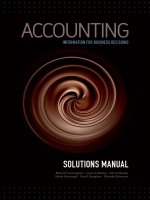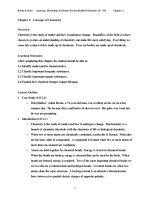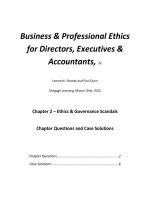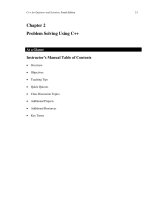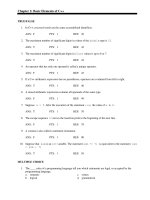Test bank and solution of c++ for engineers and statictis 4e (2)
Bạn đang xem bản rút gọn của tài liệu. Xem và tải ngay bản đầy đủ của tài liệu tại đây (184.11 KB, 7 trang )
Chapter 2: Problem Solving Using C++
TRUE/FALSE
1. Modular programs are easier to develop, correct, and modify than programs constructed in some other
manner.
ANS: T
PTS: 1
REF: 45
2. One important requirement for designing a good function is giving it a name that conveys some idea of
what the function does.
ANS: T
PTS: 1
REF: 47
3. Except for strings, double quotes, identifiers, and keywords, C++ ignores all white space.
ANS: T
PTS: 1
REF: 56
4. C++ is a case-sensitive language.
ANS: T
PTS: 1
REF: 48
5. Programs in C++ can have more than one main() function.
ANS: F
PTS: 1
REF: 48
6. Preprocessor commands end with a semicolon.
ANS: F
PTS: 1
REF: 51
7. C++ provides ten built-in integer data types.
ANS: F
PTS: 1
REF: 61
8. You cannot add and subtract character data and mix it with integer data to produce useful results.
ANS: F
PTS: 1
REF: 70
9. Although declaration statements can be placed anywhere in a function, typically they’re grouped
together and placed after the function’s opening brace.
ANS: T
PTS: 1
REF: 81
10. Omitting the parentheses after main() is a common programming error.
ANS: T
PTS: 1
REF: 97
MULTIPLE CHOICE
1. Programs with a structure consisting of interrelated segments, called ____, are arranged in a logical,
easily understandable order to form an integrated and complete unit.
a. blocks
c. units
b. modules
ANS: B
d. procedures
PTS: 1
REF: 45
2. ____ programs are easier to develop, correct, and modify than programs constructed in some other
manner.
a. Modular
c. Sequential
b. Handwritten
d. Low-level
ANS: A
PTS: 1
REF: 45
3. A ____ contains both data and functions appropriate for manipulating the data.
a. segment
c. class
b. block
d. function
ANS: C
PTS: 1
REF: 47
4. A(n) ____ is a word the language sets aside for a special purpose and can be used only in a specified
manner.
a. codeword
c. identifier
b. keyword
d. classname
ANS: B
PTS: 1
REF: 47
5. The maximum number of characters in a function name is ____.
a. 128
c. 512
b. 256
d. 1024
ANS: D
PTS: 1
REF: 47
6. A(n) ____ is a word designed as a memory aid.
a. mnemonic
c. reserved word
b. keyword
d. identifier
ANS: A
PTS: 1
REF: 48
7. The main() function is referred to as a(n) ____ function because it tells other functions the sequence
in which they execute.
a. logical
c. driver
b. auxiliary
d. class
ANS: C
PTS: 1
REF: 48
8. Data transmitted to a function at runtime is referred to as the ____ of the function.
a. return value
c. body
b. arguments
d. structure
ANS: B
PTS: 1
REF: 49
9. The ____ is an output object that sends data it receives to the standard display device.
a. out
c. print
b. cin
d. cout
ANS: D
PTS: 1
REF: 50
10. Preprocessor commands begin with a ____ sign.
a. #
c. //
b. !
ANS: A
d. */
PTS: 1
REF: 51
11. ____ in C++ are any combination of letters, numbers, and special characters enclosed in quotation
marks.
a. Arrays
c. Enums
b. Strings
d. Objects
ANS: B
PTS: 1
12. The newline escape sequence is ____.
a. \l
b. \r
ANS: C
PTS: 1
REF: 52
c. \n
d. \t
REF: 52
13. ____ are explanatory remarks made in a program.
a. Comments
c. Escape sequences
b. Strings
d. Classes
ANS: A
PTS: 1
REF: 57
14. A ____ begins with two slashes (//) and continues to the end of the line.
a. program comment
c. block comment
b. function comment
d. line comment
ANS: D
PTS: 1
REF: 57
15. A(n) ____ is an acceptable value for a data type.
a. primitive value
c. built-in value
b. literal
d. class value
ANS: B
PTS: 1
REF: 61
16. The three most important and common integer types used in most applications are int, char, and
____.
a. long int
c. bool
b. unsigned char
d. long
ANS: C
PTS: 1
REF: 61
17. The C++ operator ____ provides the number of bytes used to store values for any data type named in
the operator’s parentheses.
a. size()
c. length()
b. sizeof()
d. lengthof()
ANS: B
PTS: 1
REF: 65
18. A(n) ____ number, more commonly known as a real number, can be the number zero or any positive
or negative number that contains a decimal point.
a. boolean
c. long int
b. integer
d. floating-point
ANS: D
PTS: 1
REF: 67
19. A(n) ____ is an item used to change how the output stream of characters is displayed.
a. manipulator
b. escape sequence
ANS: A
c. string
d. char object
PTS: 1
REF: 72
20. A(n) ____ is simply a name the programmer assigns to refer to computer storage locations.
a. constant
c. expression
b. variable
d. identifier
ANS: B
PTS: 1
REF: 79
21. A(n) ____ data value is considered a complete entity and can’t be decomposed into a smaller data type
supported by the language.
a. composed
c. complex
b. atomic
d. real
ANS: B
PTS: 1
REF: 82
22. When a declaration statement is used to store a value into a variable, the variable is said to be ____.
a. initialized
c. reserved
b. deleted
d. used
ANS: A
PTS: 1
REF: 83
23. The value stored in the variable is referred to as the variable’s ____.
a. address
c. data
b. location
d. contents
ANS: D
PTS: 1
REF: 86
24. To determine the address of a variable, we can use C++’s address operator, ____, which means “the
address of.”
a. *
c. &
b. =
d. !
ANS: C
PTS: 1
REF: 88
25. A common programming error consists of forgetting to separate data streams sent to cout with the
insertion symbol, ____.
a. <
c. >>
b. >
d. <<
ANS: D
PTS: 1
REF: 97
COMPLETION
1. A program consists of subprograms, called ____________________, that are designed and developed
to perform a specific task.
ANS: modules
PTS: 1
REF: 46
2. In C++, a module can be a class or a(n) ____________________.
ANS: function
PTS: 1
REF: 46
3. In an object-oriented language, such as C++, a(n) ____________________ encapsulates both data and
sets of operations.
ANS: class
PTS: 1
REF: 47
4. In a function header, the ____________________ before the function name defines the type of value
the function returns when it has completed operating.
ANS: keyword
PTS: 1
REF: 49
5. Each ____________________ inside the function body must end with a semicolon (;).
ANS: statement
PTS: 1
REF: 50
6. The output object that sends data it receives to the standard display device, or console, is called
____________________.
ANS: cout
PTS: 1
REF: 50
7. The ____________________ and ostream classes provide the data declarations and methods used
for data input and output, respectively.
ANS: istream
PTS: 1
REF: 51
8. C++ supports two types of comments: line and ____________________.
ANS: block
PTS: 1
REF: 57
9. A(n) ____________________ is defined as a set of values and a set of operations that can be applied
to these values.
ANS:
data type
class
PTS: 1
REF: 60
10. In C++, a(n) ____________________ character changes the normal interpretation of the character
following it and alters its meaning.
ANS: escape
PTS: 1
REF: 52
11. The ____________________ data type is used to store single characters.
ANS: char
PTS: 1
REF: 62
12. A(n) ____________________ data type allows negative values to be stored as well as zero and
positive values.
ANS: signed
PTS: 1
REF: 66
13. In C++, a(n) ____________________ is any combination of operators and operands that can be
evaluated to yield a value.
ANS: expression
PTS: 1
REF: 73
14. A(n) ____________________ statement names a variable and specifies the data type that can be stored
in it.
ANS: declaration
PTS: 1
REF: 80
15. Variables used to hold single-precision values are declared by using the keyword
____________________.
ANS: float
PTS: 1
REF: 67
16. Every variable has three major items associated with it: its data type, the value stored in it, and its
____________________.
ANS: address
PTS: 1
REF: 87
17. Forgetting to enclose a string sent to ____________________ with quotation marks is a common
programming error.
ANS: cout
PTS: 1
REF: 97

